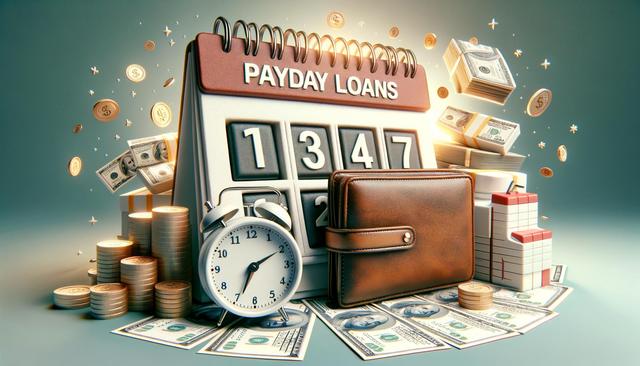How Payday Loans Bridge Short-Term Financial Gaps
While payday loans may offer short-term relief, their long-term financial consequences highlight the importance of approaching them with caution and exploring sustainable solutions whenever possible.

Understanding How Payday Loans Work
Payday loans are a form of short-term loans that are typically designed to cover emergency expenses or help individuals manage financial shortfalls between paychecks. These types of loans are often marketed as quick solutions for urgent needs, such as medical bills, car repairs, or rent. The process usually involves borrowing a small amount of money, with the expectation that it will be repaid in full—along with fees and interest—on the borrower’s next payday.
Due to their convenience and speed, payday loans are commonly used by individuals who may not qualify for traditional lending products. However, they often come with high fees that translate into annual percentage rates (APRs) that are significantly higher than those of other financing options. As a result, these high-interest loans can quickly become burdensome if not managed carefully.
Common features of payday loans include:
- Short repayment periods, typically two to four weeks
- Minimal credit checks
- Quick approval and disbursement
- High fees relative to the loan amount
While they can be useful in specific situations, understanding the mechanics and costs involved is essential to avoid unintentional financial strain.
The Appeal and Risks of Quick Cash Access
One of the main reasons payday loans remain popular is their ability to provide a fast cash advance when other options may not be available. For individuals facing a temporary financial crunch, the immediate availability of funds can be a lifeline. This convenience, however, often comes at a steep price, and borrowers may underestimate the long-term impact of accepting such loans.
The appeal of payday loans includes:
- No need for collateral
- Fast processing, often within hours
- Availability to those with poor credit history
Despite these advantages, the risks are significant. The short repayment terms and high-interest rates can make it difficult for borrowers to repay the loan on time. This frequently results in taking out additional loans to cover the previous ones, creating a cycle commonly known as a debt trap. In many cases, borrowers end up paying far more in interest and fees than the original loan amount.
Moreover, repeated borrowing can lead to dependence on payday loans, making it harder to achieve financial stability in the long term.
Recognizing the Signs of a Debt Trap
One of the most concerning aspects of payday loans is the potential to fall into a debt trap. A debt trap occurs when a borrower continuously takes out new loans to pay off previous ones, often due to high fees and short repayment windows. This cycle can quickly become unsustainable, leading to mounting debt and financial stress.
Indicators that a person may be caught in a debt trap include:
- Repeated borrowing to cover loan payments
- Accumulating additional fees and penalties
- Struggling to pay for basic living expenses due to loan repayments
- Borrowing from multiple lenders simultaneously
Once in a debt trap, it can be difficult to break free without outside assistance or intervention. Some borrowers may even turn to informal or illegal lending sources, sometimes referred to as loan shark operations, which often involve even higher rates and severe consequences for late payments. Recognizing these signs early is key to preventing deeper financial hardship.
Exploring Alternatives to Payday Loans
Given the risks associated with payday loans, it’s important to explore alternative solutions that may offer more sustainable financial support. Several options exist that can help individuals manage short-term cash needs without incurring the heavy costs associated with high-interest loans.
More manageable alternatives include:
- Credit union loans with lower interest rates
- Payment plans with service providers (e.g., utilities, landlords)
- Employer-based paycheck advances
- Community assistance programs or non-profit financial aid
- Budgeting and financial counseling services
In addition, building an emergency fund, even in small amounts, can create a buffer for future financial needs. Financial education resources can also empower individuals to make informed decisions and reduce reliance on short-term loans.
By considering these alternatives, borrowers can potentially avoid the cycle of payday lending and work toward greater financial resilience.
Managing Short-Term Financial Needs Responsibly
When faced with a financial emergency, the pressure to find immediate solutions is understandable. However, it’s crucial to weigh the long-term consequences of any borrowing decision. While payday loans can provide a temporary fix, they also carry significant risks that can impact financial health for months or even years.
Responsible management of short-term financial needs involves:
- Assessing all available options before borrowing
- Understanding the full cost of any loan, including fees and interest
- Only borrowing what you can realistically repay
- Seeking guidance from financial professionals if needed
Awareness and education play a pivotal role in helping individuals avoid predatory lending practices. By making informed choices and prioritizing sustainable financial strategies, individuals can bridge short-term financial gaps without compromising their long-term stability.
Conclusion: Making Informed Financial Decisions
Payday loans can offer a quick solution for immediate financial needs, but they come with substantial risks that should not be overlooked. High-interest loans and the potential for falling into a debt trap make it important for borrowers to proceed with caution. Rather than relying on cash advance services or risking involvement with a loan shark, exploring safer and more affordable alternatives can lead to more secure financial outcomes. By staying informed and considering all available resources, individuals can better navigate short-term challenges while protecting their long-term financial well-being.